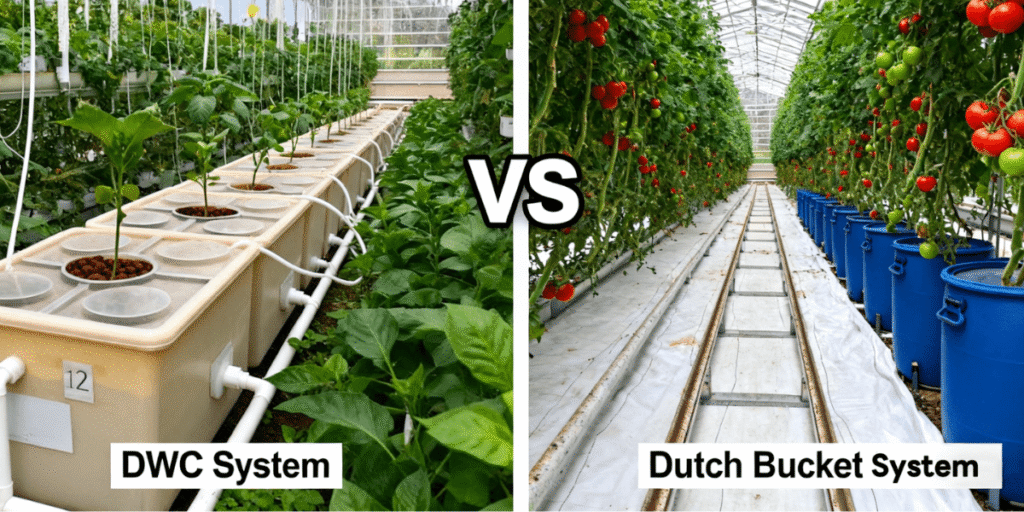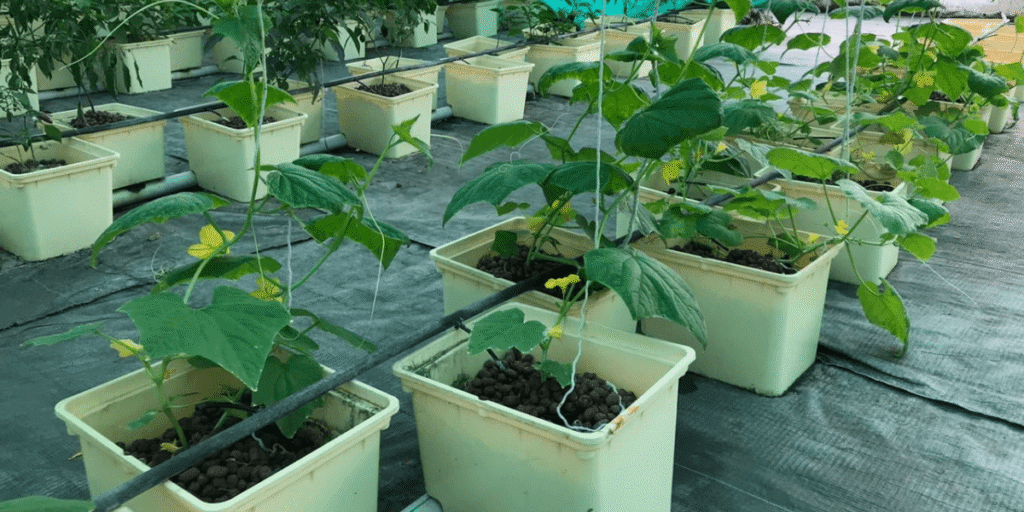Dutch Bucket vs DWC is one of the most common questions for both new and experienced hydroponic growers. Choosing the right hydroponic setup affects everything from what plants you can grow to the time and effort needed for maintenance, and ultimately, the size of your harvest. With so many hydroponic acronyms, including DWC, NFT, and Dutch Buckets, it’s easy to feel overwhelmed.
Dutch Bucket vs DWC compares two of the most popular hydroponic systems. The Dutch Bucket System works best for larger fruiting crops like tomatoes and peppers, while Deep Water Culture (DWC) provides a nutrient-rich environment ideal for leafy greens and herbs. By understanding the key differences, system requirements, and plant compatibility, you can choose the setup that best fits your gardening goals, space, and resources.
What Is a Dutch Bucket System in Hydroponics
The Dutch Bucket System is a highly versatile and widely used hydroponic setup, especially popular among commercial growers who need to handle large or heavy-feeding plants. At its core, the system uses individual containers, or “buckets,” each filled with an inert growing medium such as perlite, coco coir, or a similar substrate that holds moisture and supports the roots.
Nutrient solution is delivered to each plant through a drip line, usually controlled by a timer to ensure consistent feeding. Any excess solution that the plant doesn’t absorb simply drains out the bottom of the bucket and flows back into a central reservoir, where it is recirculated. This recirculation not only saves water and nutrients but also allows the grower to monitor and adjust the solution more efficiently.
One of the biggest advantages of the Dutch Bucket System is its flexibility. Each plant grows in its own space, which reduces competition for nutrients and allows you to support larger, vining plants with stakes or trellises. It is ideal for crops like tomatoes, cucumbers, peppers, and squash, which need strong support and plenty of nutrients to produce heavy yields.
Overall, the Dutch Bucket System combines efficiency, scalability, and plant health in one modular setup. It’s a reliable choice if you want to grow larger, fruiting plants and get consistent, high-quality harvests.
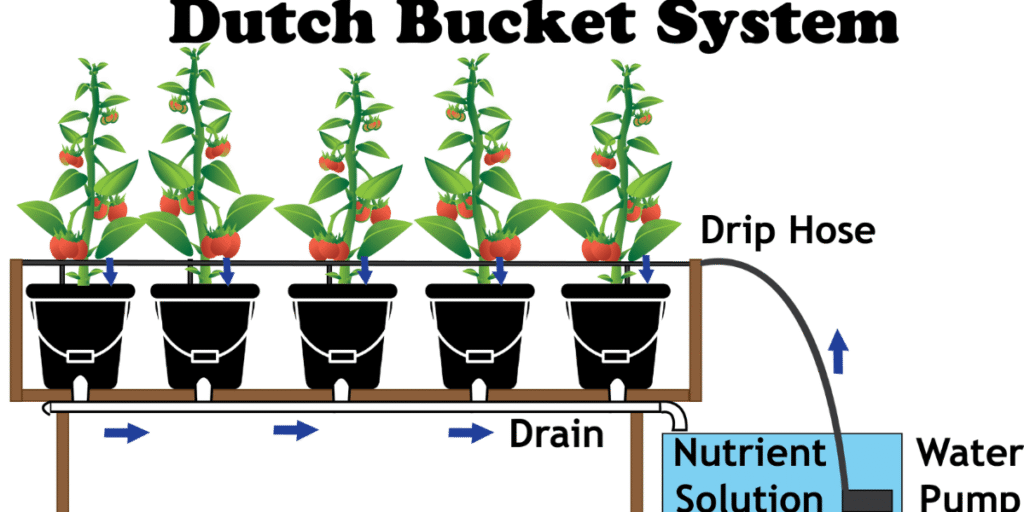
Understanding DWC for Indoor Gardening Success
Deep Water Culture, or DWC, is one of the simplest and most beginner-friendly hydroponic methods. It’s perfect for growers who want to see quick results without dealing with complex equipment or setups. In a DWC system, plants are placed in net pots, and their roots hang directly into a reservoir filled with nutrient-rich water.
An air stone connected to an air pump continuously bubbles air into the water, ensuring the roots receive plenty of oxygen along with nutrients. This combination of food and oxygen allows plants to grow quickly and stay healthy, since roots never have to search for nutrients in soil—they have everything they need right in the water.
DWC is especially well-suited for fast-growing, leafy crops such as lettuce, kale, spinach, herbs, and certain small strawberry varieties. These plants thrive in the constant nutrient supply and oxygen-rich environment, and you’ll often see impressive growth rates compared to soil-based cultivation. Another great thing about DWC is its simplicity. With fewer moving parts, there’s less maintenance, making it ideal for beginners or anyone looking to grow indoors or in a limited space.
Overall, DWC provides a straightforward, efficient, and highly effective way to grow leafy greens and other small, fast-growing plants while keeping your setup manageable and easy to maintain.
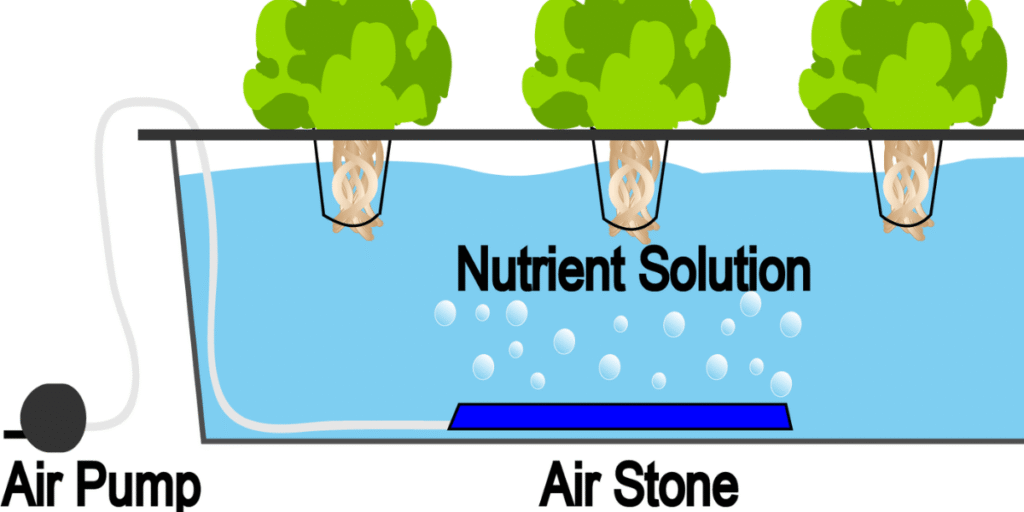
Dutch Bucket vs DWC: Key Growth Differences
| Feature | Dutch Bucket System | Deep Water Culture (DWC) |
|---|---|---|
| Root Environment | Plants grow in an inert medium like coco coir or perlite, which supports the roots and helps retain moisture. | Roots hang directly in highly oxygenated nutrient solution, getting nutrients and oxygen continuously. |
| Water Delivery | Nutrient solution is delivered through a pulsed drip system on a timer, and excess drains back to a central reservoir. | Roots are constantly submerged in nutrient-rich water, with oxygen provided by an air stone. |
| Physical Support | Excellent. The growing medium holds heavy plants upright, making it perfect for large fruiting crops. | Minimal. Plants often need stakes or trellises for support, especially for heavier or vining varieties. |
| System Complexity | Medium to high. Requires pumps, timers, tubing, and return lines. | Low. Only needs a reservoir, net pots, an air pump, and an air stone. |
Advantages at a glance:
- Dutch Bucket: Strong support for large, fruit-bearing plants; ideal for tomatoes, cucumbers, peppers, and squash.
- DWC: Simple, easy to set up, very efficient with water and nutrients; great for fast-growing leafy greens and herbs.
Choosing Between Dutch Bucket and DWC Systems
The Dutch Bucket System is a modular hydroponic setup where each plant grows in its own bucket filled with an inert medium such as coco coir or perlite. Nutrient solution is delivered to each plant through a timed drip system, and any excess drains back into a central reservoir for recirculation. This setup is especially well-suited for large, fruiting plants because the medium provides strong physical support and helps reduce competition among roots. Crops like tomatoes, cucumbers, peppers, and squash thrive in Dutch Buckets, with nutrients evenly distributed to each plant, making it possible to achieve high yields and consistent quality.
In contrast, Deep Water Culture, or DWC, is known for its simplicity and efficiency. In this system, plant roots are suspended directly in highly oxygenated nutrient solution, with an air stone constantly supplying oxygen. This allows the roots to absorb both nutrients and oxygen continuously, promoting rapid growth. DWC works particularly well for fast-growing leafy greens and herbs such as lettuce, kale, spinach, and various culinary herbs. It’s easy to maintain, takes up minimal space, and is ideal for indoor gardening, making it a great choice for beginners or anyone looking to grow crops quickly from seed to harvest.
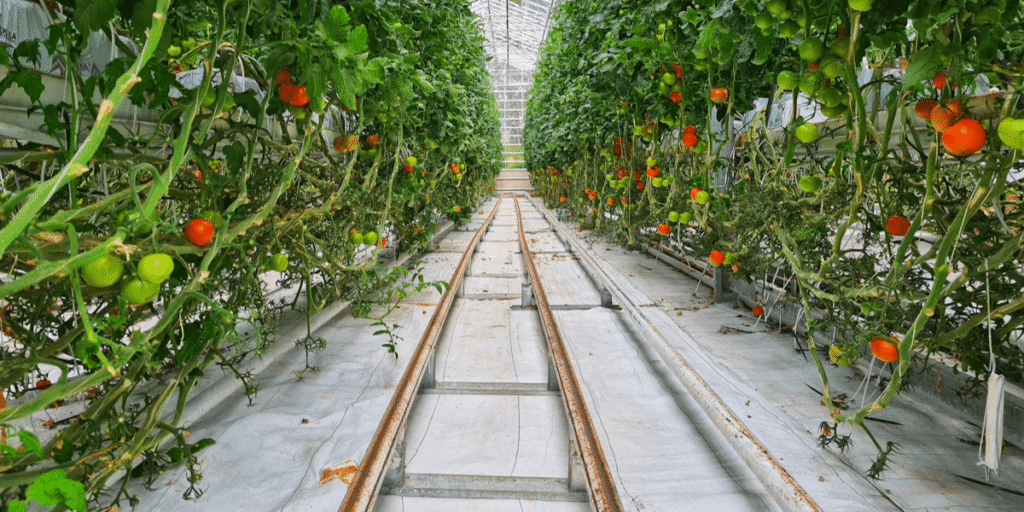
Pros and Cons of Dutch Buckets for Fruiting Plants
Why Dutch Buckets Work for Tomatoes and Peppers
- Strong and Versatile: Want to grow a tall, heavy tomato or cucumber? Dutch Buckets have your back. The medium supports the plant while delivering nutrients right where they’re needed.
- Easy to Manage: Each bucket is its own little unit. If one plant gets sick or needs its medium changed, you can handle it without disturbing the rest.
- Happy Roots: The growing medium, like coco coir or perlite, keeps roots well-aerated. This means less risk of suffocating the roots compared to systems where plants just sit in water.
Common Mistakes in Dutch Bucket and DWC Systems
- Setup Takes Work: Be ready to spend some time on plumbing. Drip lines, return pipes, and siphons take effort and cost a bit more than a simple DWC setup.
- Water and Nutrients: Because the system relies on timed drip cycles to keep the medium properly wet, it can use more water and nutrients than other systems, and keeping the schedule consistent is important.
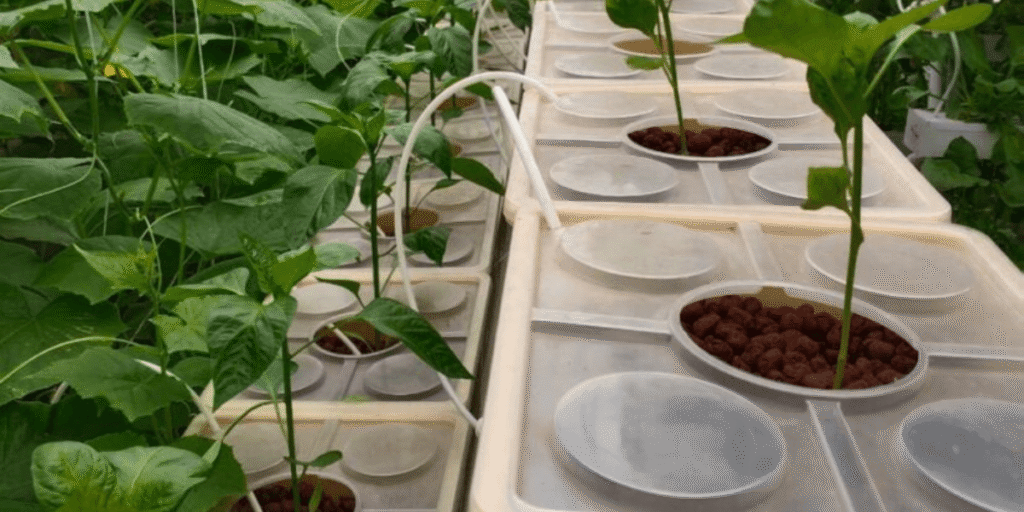
Pros and Cons of DWC for Leafy Greens
Why DWC Excels in Fast-Growing Hydroponics
- Simple and Affordable: DWC is super easy to set up and won’t break the bank. It’s perfect if you’re just starting out and want a quick, satisfying hydroponic project.
- Fast Growth: Plants love having their roots constantly in oxygen-rich nutrient solution. Leafy greens and herbs like lettuce and basil grow impressively fast.
- Water-Smart: The system uses water efficiently, with minimal evaporation, and the reservoir makes it easy to see and adjust nutrient levels.
Things to Consider When Picking Dutch Bucket or DWC
Not for Heavy Plants: DWC isn’t ideal for big, heavy crops like mature peppers or melons. These plants need more physical support than the system provides.
Temperature Sensitivity: Roots sit directly in water, so temperature swings can happen easily. If it gets too warm, root rot can become a problem.
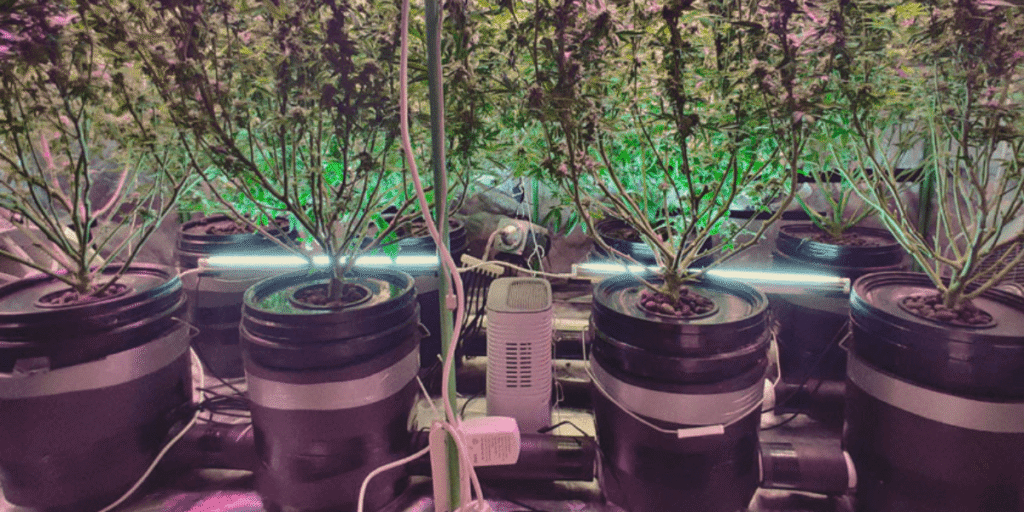
How Growing Media Impacts Dutch Bucket and DWC
| Growing Medium | Advantages | Things to Watch Out For |
|---|---|---|
| Clay Pebbles (Hydroton) | Drains extremely well, reusable, pH neutral. | Doesn’t hold much water, so frequent dripping is needed. |
| Coco Coir | Holds water well and allows plenty of oxygen for roots. | Needs buffering before use to remove salts, can compact over time. |
| Perlite | Very light, excellent aeration, drains quickly. | Holds very little water, and can be washed out of the bucket easily. |
Choosing the right growing medium for a Dutch Bucket system is crucial. Expanded clay provides excellent drainage, coconut coir balances moisture and aeration, and perlite is lightweight and highly porous, though it dries quickly. At the same time, using a pH timer or pH/EC meter to monitor the nutrient solution ensures plants grow in optimal conditions, improving yield and quality.
Comparing Cost and Complexity of Hydroponic Systems
| Feature | Dutch Bucket | Deep Water Culture (DWC) |
|---|---|---|
| Initial Cost (per plant) | Medium to high – more components like buckets, tubing, and drip lines increase setup costs. | Low – simple reservoir, net pots, and air pump keep costs minimal. |
| Maintenance Difficulty | Medium – you need to check each drip line and bucket regularly to ensure proper flow. | Low – mostly monitoring the reservoir and air stone, much less hands-on work. |
| Space Utilization | High – buckets can be arranged vertically or in rows to maximize space. | Low – reservoirs take up horizontal space, limiting stacking options. |
Dutch Buckets cost more and require more hands-on maintenance but are great for larger plants and vertical setups. DWC is cheaper and easier to manage, ideal for leafy greens in smaller or indoor spaces.
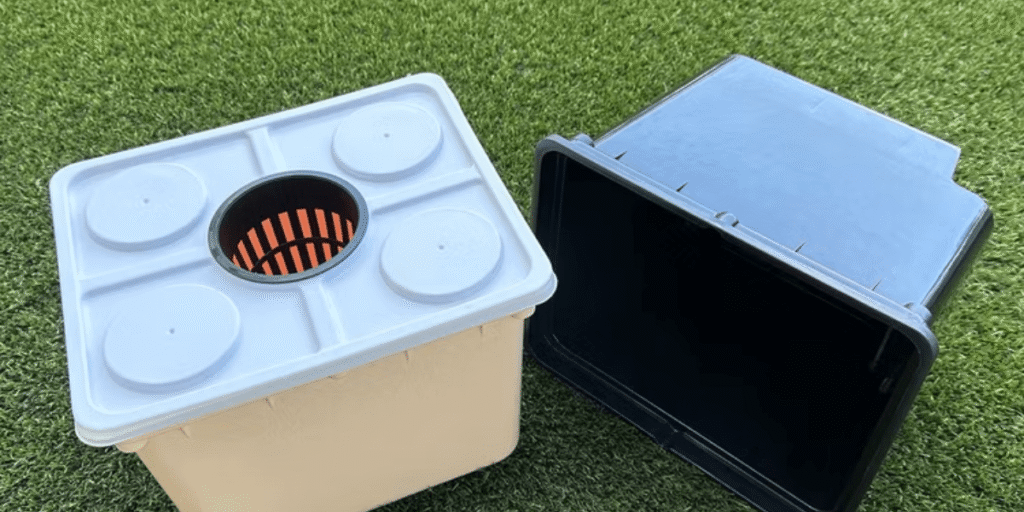
Disease Management Tips for Dutch Bucket and DWC
No matter which hydroponic system you use, keeping diseases under control is absolutely critical. In a recirculating setup like the Dutch Bucket system, water flows back into a central reservoir. This means that if even one plant gets infected with a pathogen, it can quickly spread to the entire crop if you’re not careful.
Isolation Strategies to Protect Hydroponic Plants
As soon as you notice any signs of disease such as yellowing leaves, wilting, or unusual spots act immediately. Remove the affected bucket from the system and isolate it. Don’t wait and hope it won’t spread. By removing the infected plant and its medium, you prevent the pathogen from contaminating the rest of your crops.
Using Drain-to-Waste Safely in Hydroponic Systems
Many commercial growers take an extra step to reduce disease risk: instead of recirculating the nutrient solution, they run a “drain to waste” system. In this setup, all excess nutrient solution is discarded rather than returned to the main reservoir. This approach uses more water, but it virtually eliminates the chance of a single infection spreading throughout the system. For growers with large or high-value crops, the extra water cost is a small price to pay for keeping plants healthy and maximizing yield.
Monitoring Tips for Healthy Dutch Bucket and DWC
Beyond these strategies, routine checks and maintaining a clean system are essential. Inspect plants daily, clean your buckets and tubing regularly, and keep tools and hands sanitized when working with the system. Prevention is always better than cure, especially in hydroponics, where pathogens can travel faster than you might expect.
FAQs About Dutch Bucket and DWC Hydroponics
Q1: How often should I check pH and EC?
A: Both systems benefit from daily monitoring, especially when plants are young. DWC is simpler you mostly just check the main reservoir. For Dutch Buckets, check the reservoir daily, and every now and then, check the runoff from a bucket to make sure nutrients are being absorbed properly.
Q2: Which system is better for beginners?
A: DWC is usually the easiest for beginners. The setup is straightforward, there’s minimal plumbing, and it’s easy to maintain.
Q3: Can I grow herbs in a Dutch Bucket system?
A: You can, but it’s often overkill. Dutch Buckets are designed for larger, fruiting plants. For small leafy herbs, DWC or NFT is much more efficient and cost-effective.
Q4: Do I need to replace the growing medium in Dutch Buckets?
A: It depends on the medium. Inert media like clay pebbles can be cleaned and reused multiple times. Organic media like coco coir should ideally be replaced after 1–2 growing cycles to prevent salt buildup and reduce the risk of pathogens.
Q5: Which system uses more electricity?
A: DWC mostly runs a continuous air pump, while Dutch Buckets use both an air pump and a water pump on a timer. The difference isn’t huge, but DWC is usually slightly more energy-efficient.
Conclusion: Picking the Right Hydroponic System
Both the Dutch Bucket system and Deep Water Culture (DWC) are excellent hydroponic methods, but they shine in different ways. Choosing the right system ultimately comes down to the types of plants you want to grow and how much time, space, and effort you’re willing to invest.
DWC is perfect for beginners or anyone who values simplicity. Its straightforward setup, minimal plumbing, and efficient use of water and nutrients make it ideal for fast-growing, leafy crops like lettuce, kale, herbs, and some strawberries. It’s a low-maintenance system that lets you see results quickly, making it a great choice for small indoor gardens or first-time hydroponic growers.
On the other hand, the Dutch Bucket system is a highly flexible and efficient solution for those aiming for high yields and larger, fruit-bearing plants. Its modular design allows you to grow tall tomatoes, peppers, cucumbers, and other heavy feeders with strong physical support and precise nutrient delivery. While it requires more setup and maintenance than DWC, the ability to scale, support large plants, and manage individual buckets makes it a favorite for serious growers who want both quality and quantity.
In the end, your choice should reflect your growing goals. If you’re after speed, simplicity, and leafy greens, DWC will serve you well. If you’re aiming for high production, versatility, and the ability to cultivate larger crops, the Dutch Bucket system is the way to go. Both systems have their strengths you just need to match the method to your plants and your growing style.
Ready to Build Your Dutch Bucket or DWC Setup
Whether you choose the simplicity of DWC or the versatility of Dutch Buckets, having the right equipment makes all the difference. From reliable air pumps and sturdy buckets to precise pH and EC monitoring tools, we provide everything you need to build a productive and high-yield hydroponic garden.
Get started with confidence. Explore our full range of hydroponic components, nutrient solutions, and starter kits today. If you need guidance, our team at Greenfuturehydro is always ready to help you design, set up, and optimize your system for the best results.
Join our community of hydroponic enthusiasts, follow us on Instagram at @Greenfuturehydro, and take the first step toward growing healthy and thriving plants with ease.And don’t worry,you’re never on your own. If you have questions or need advice, reach out to us at info@greenfuturehydro.com or call +86 13487543942. We love helping growers of all levels achieve success with hydroponics.
